Red beaks are common on various species of ducks. These types of beaks are seen on ducks in North America on male ducks and on both males and females on many South American species.
With a preference for freshwater or saline waters, ducks with red beaks can be dabblers, divers, or different other types of species, including perching ducks that like to rest up on trees.
Regardless of their species and genus, the following ducks can be spotted in different locations across the world.
Table of Contents
1. Wood Duck
Scientific name: Aix sponsa
Type: perching duck (found on trees)
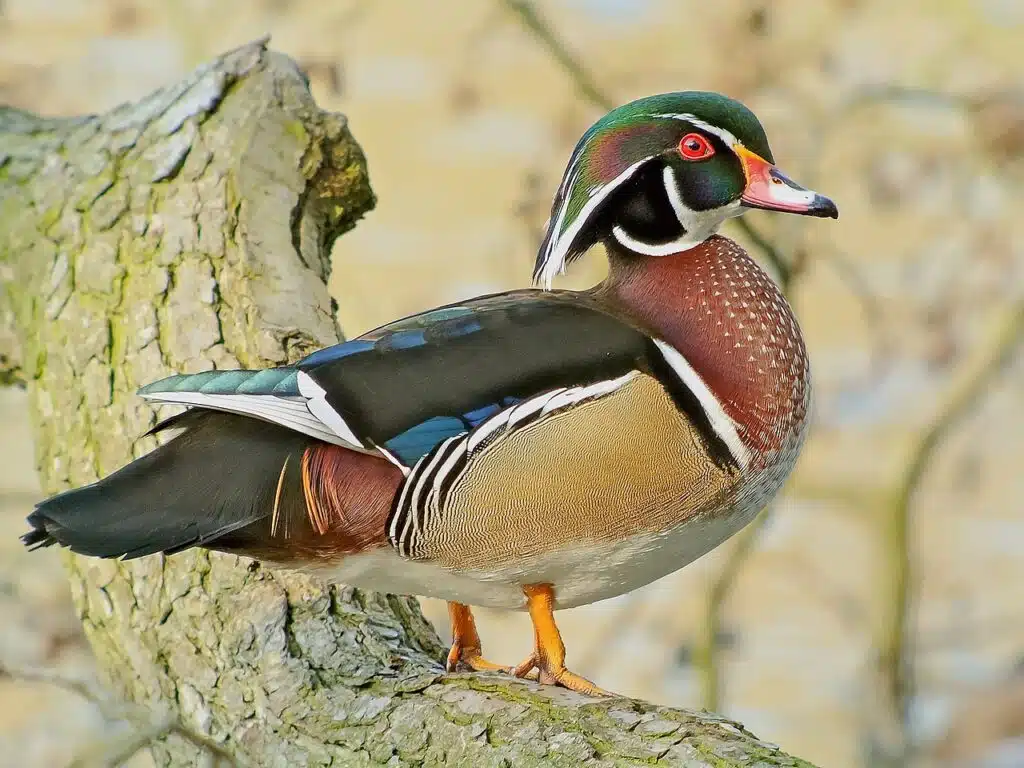
A species with a highly colorful appearance, Wood Ducks are also known for their contrasting colors and colored beaks.
A mostly red or orange-red beak is seen on male Wood Ducks. Males also show a gray section of the tip of the beak.
Female Wood Ducks also have orange-red and gray beaks, but are dominated by a gray beak color and by gray plumage as opposed to the highly colorful plumage of males.
A flying duck that may or may not migrate, Wood Ducks also come in a few different other colors.
For example, males can be mostly black. Their beaks are still orange-red but they may also show white sections and even black margins or black tips.
Distribution: Northern, Eastern, and Southern United States
2. Common Merganser

Scientific name: Mergus merganser
Type: seaduck
Both male and female Common Mergansers have a similar appearance outside of the breeding season.
They show dark red-brown head plumage, a matching crest, and a red beak.
Once the breeding season starts, males change their appearance while females maintain their appearance.
Males turn black on top with a black head and a dark red-brown beak.
Apart from the color of the beak, these seaducks also stand out with the actual shape of the beak. Serrations are spotted on the bill which helps them grip fish, their favorite food.
Distribution: North America, Europe, Asia
3. Black-bellied Whistling-Duck
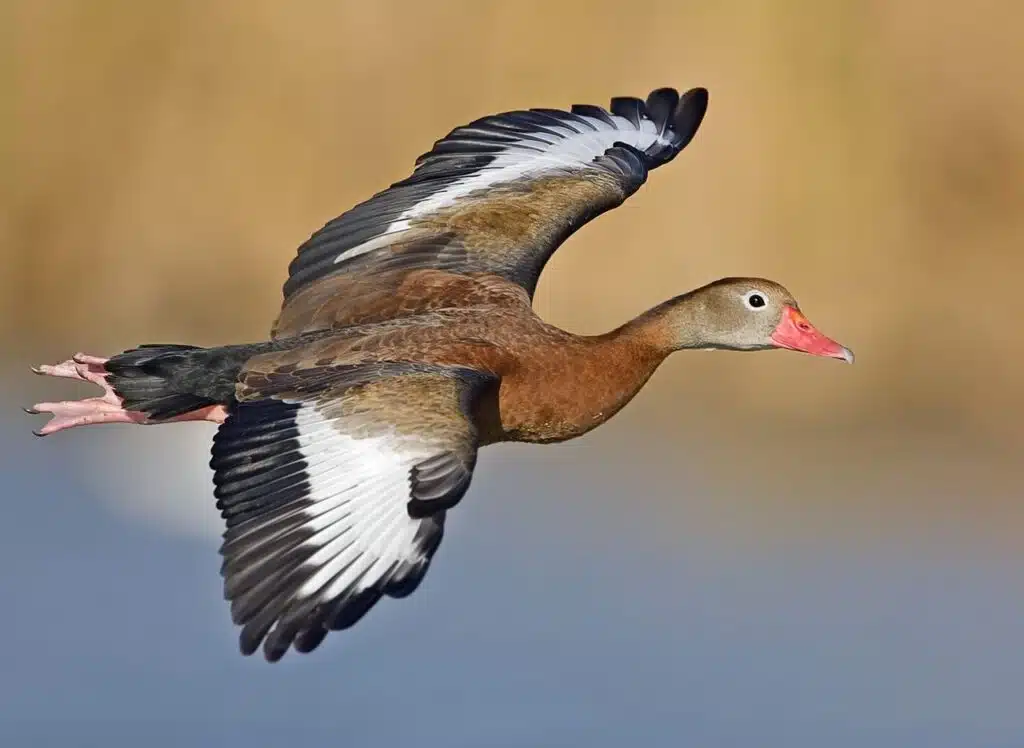
Scientific name: Dendrocygna autumnalis
Type: tree duck
Also known as The Red-bellied Whistling-Duck, this is a species of tree duck that comes with a bill of different red nuances.
All of the red nuances of the beak are red. From pale red to vivid red, the beak of the species stands out immediately.
The beak of these ducks that whistle isn’t always red. They are initially dark gray or black with chicks, slowly being colorful as they grow and become breeding adults.
Color variations are also seen in the plumage of these ducks, depending on their range. However, red-brown, black, and white nuances tend to be highly common in these ducks.
Also part of the waterfowl family, these ducks have white markings only fully visible when the wings are spread out.
Distribution: Central America, Northern, and Central South America
4. Red-breasted Merganser
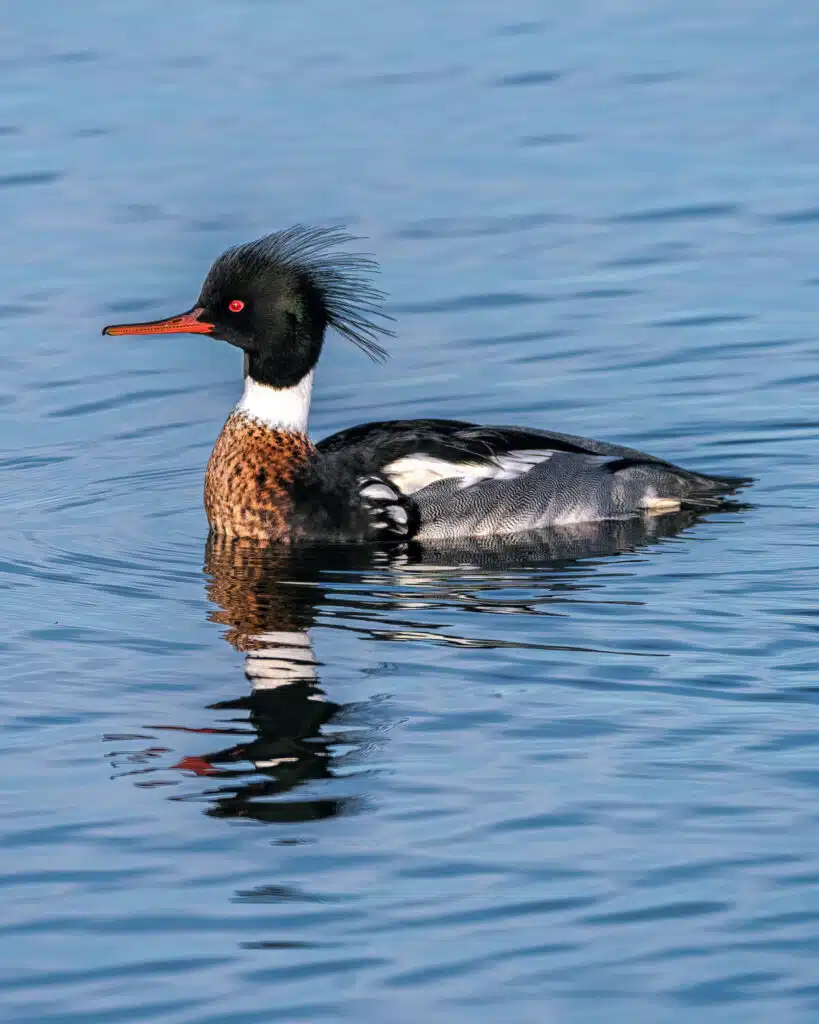
Scientific name: Mergus serrator
Type: mergansers (ducks that eat fish)
Red-breasted Mergansers have rusty red beaks. This beak can be brighter, and closer to orange nuances.
Ducks of the species are known for having short crests that can raise and lower.
The black heads of males or gray heads of females are contrasted by the red beak which shows saw-like teeth or projections.
These projections help these mergansers catch fish.
Fish in lakes or oceans are commonly eaten by these ducks. They are true mergansers that may live in saltwater.
Red-breasted Mergansers can migrate toward coastlines to overwinter.
Distribution: North America, Europe, Asia
5. Common Shelduck
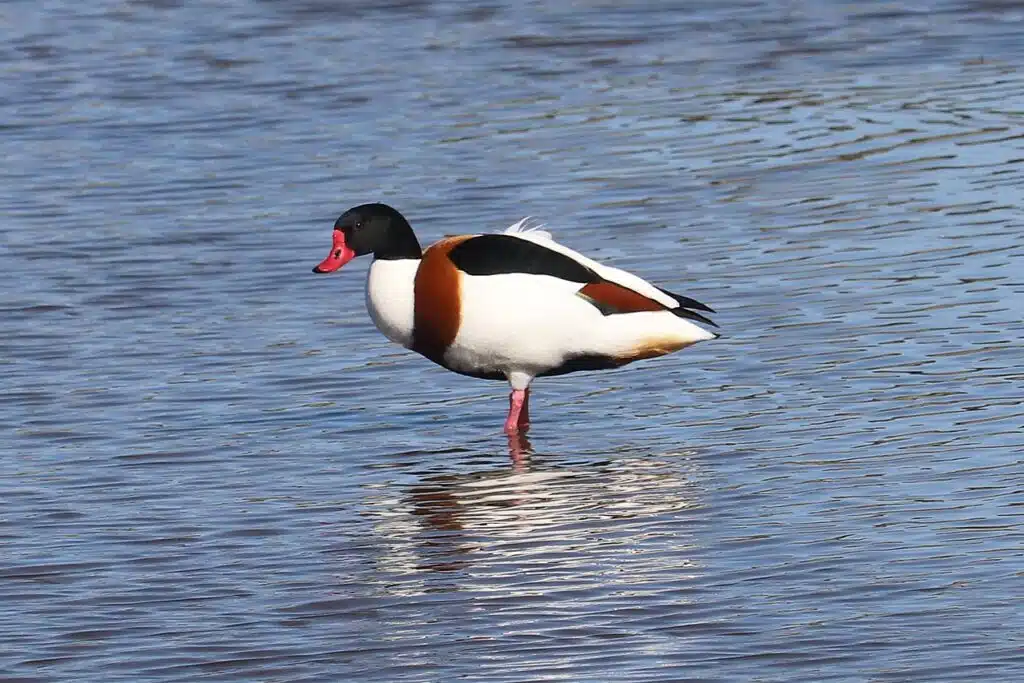
Scientific name: Tadorna tadorna
Type: semi-terrestrial
Common Shelducks are some of the most numerous ducks in the world. Found in salt marshes and an occasional species in North America, these types of ducks also have red beaks.
It’s the male duck that has the most vivid red beak as well as a red knob around the beak.
Females have a pale red beak which may be pink or pink and black.
This is a species that has white plumage and a black head both in males and females.
Young chicks have a white and black head and a matching black beak.
A species that live in temperate climates, these ducks fly to warmer climates to overwinter.
Distribution: Europe, Asia
6. Long-tailed Duck
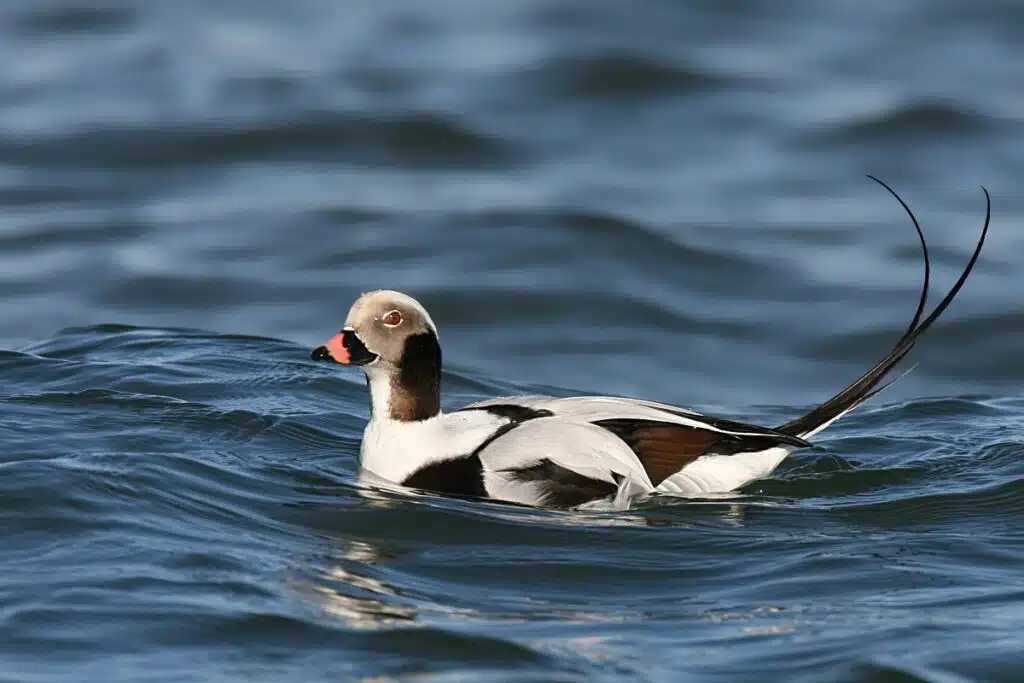
Scientific name: Clangula hyemalis
Type: seaduck
A species of the tundra, Long-tailed Ducks are among the most common species of the tundra.
It lives both in saltwater on the coast as well as in temporary or permanent freshwater bodies in the tundra.
The red beak of the species is pale and combined with black sections. This color combination is specific to males.
A considerable transformation is specific to the male Long-tailed Duck going into the breeding season.
It changes its appearance to black and white while its beak becomes colorful.
Females of the species are mostly brown. They have a white face and their beak is black or dark brown.
Distribution: North America, Greenland, Northern Eurasia
7. Mandarin Duck

Scientific name: Aix galericulata
Type: perching duck
Mandarin Ducks show a highly differentiable species between the appearance of males and females.
The male is colorful and multicolored. Its plumage makes it look like the species has colorful patches across its body and wings.
The beak of the male duck is mostly bright red. It has a white tip and it maintains this look up until the end of the breeding season.
Dull-colored females are dominated by various nuances of gray. Small blue patches are seen on the wing tips of females.
There are many other types of Mandarin Duck colors but these aren’t officially recognized.
Behavior-wise, these ducks aren’t as aggressive as others and they even prefer to hide on trees and in vegetation during the day.
Distribution: East China, Japan
8. Red-crested Pochard
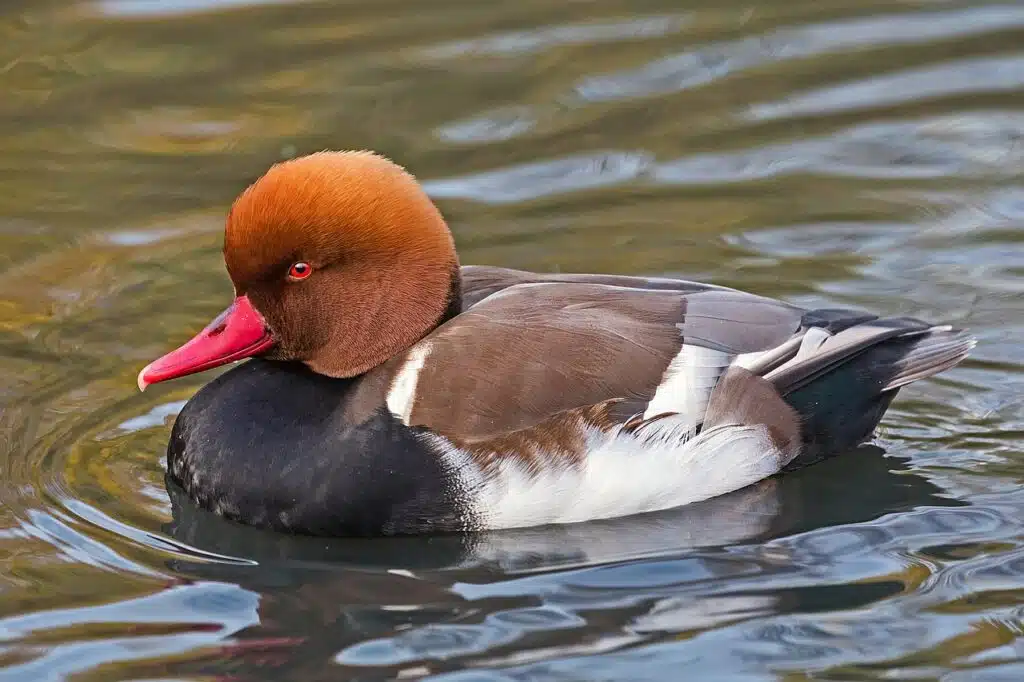
Scientific name: Netta rufina
Type: diving duck
A freshwater diver, Red-crested Pochards are among the species with the most vivid red beaks on the planet.
Males have some of the brightest red beaks with a similar red-brown head. Their red beaks aren’t the only vivid red body part as males also have vivid red eyes.
Females have black beaks that are dominated by gray nuances.
A species that dive for food, these ducks can also dive longer than other species.
Some of the best times to see these ducks include the breeding season as well as wintertime as they tend to live in flocks once the breeding period ends.
Distribution: Europe, North Africa, Asia
9. White-cheeked Pintail
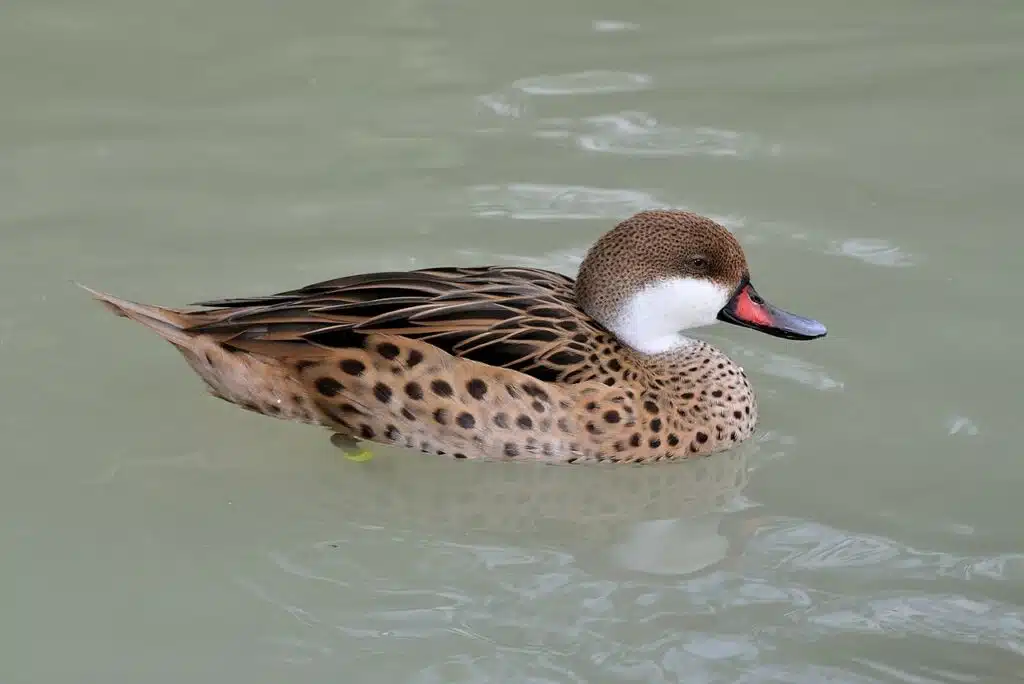
Scientific name: Anas bahamensis
Type: dabbling duck
White-cheeked Pintails are named after their white faces. These white faces are seen in non-breeding males and females.
Much of their appearance pales in front of their bright red beaks. As with most species, these red beaks are only seen on breeding males.
It takes the breeding season for males to show a red beak and a brown-red head. Bright brown and black colors dominate male plumage.
Females have a black and orange beak while the plumage is bright and dark brown.
Some of the variants of the species also come with red beaks, even in the case of its rare white morph.
A duck that is establishing itself in new territories, White-cheeked Pintails are mostly dabblers of The Americas.
Distribution: The Caribbean, South America
10. Rosy-billed Pochard
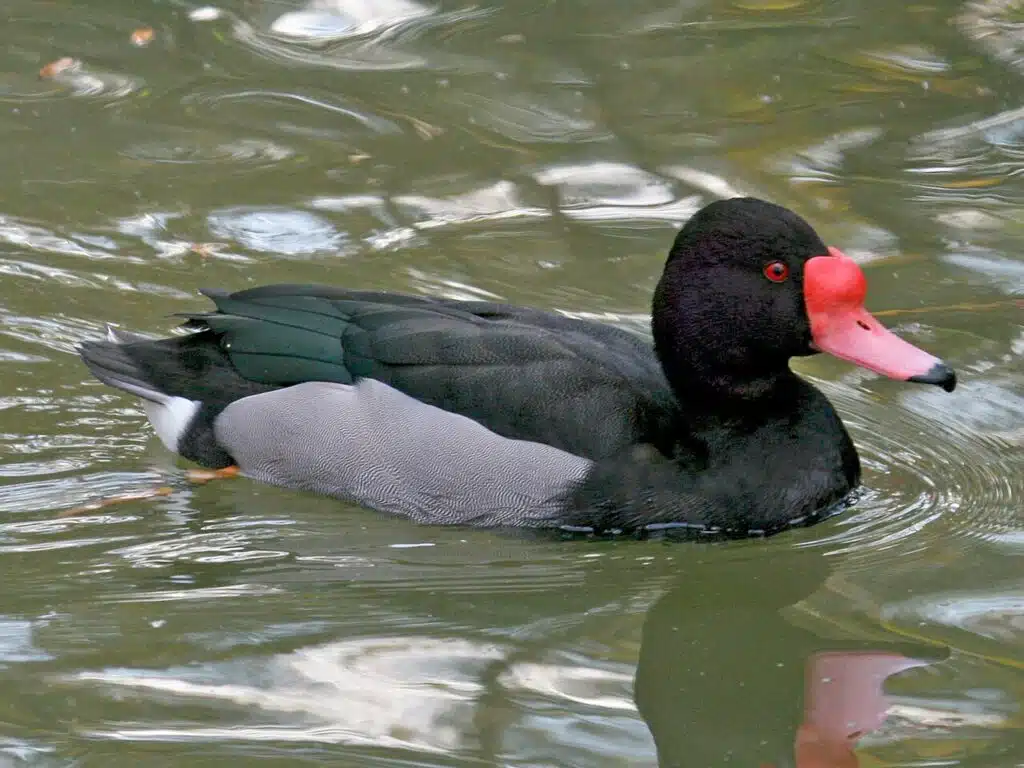
Scientific name: Netta peposaca
Type: diving duck
A species that feeds on plants and invertebrates, Rosy-billed Pochard is one of South America’s red-billed ducks.
Males of the species stand out immediately with their red beaks and red knows on their black heads.
This duck also shows a black neck, and gray and green wings with iridescence.
Females are mostly brown with a bright blue beak.
These types of ducks are often found on plantations, especially as a pest of rice.
As a result, some of its limited human interaction is subject to conservation concerns as the species is hunted for food or as a pest.
Still, Rosy-billed Pochards are increasing in population.
Distribution: Argentina, Brazil
11. Red-billed Teal
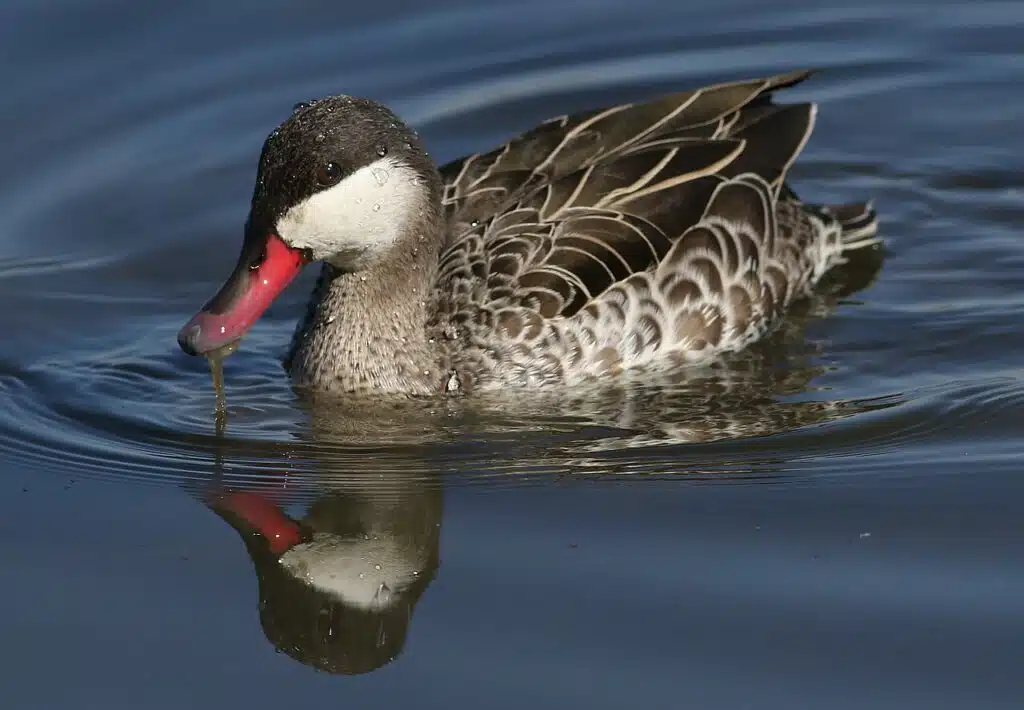
Scientific name: Anas erythrorhyncha
Type: dabbling duck
Red-billed Teals are natives of Africa, particularly sub-Saharan East Africa.
A bright red bill is specific to these ducks that feed by dabbling. This bill has a central black stripe as well as a black border close to the face.
The head of the species is formed of white and black or dark brown colors with a darker cap.
Gray and dark brown nuances are further specific to its plumage.
Growing to 19 inches, this is a species that feeds on plants and grasses. It also lays a small number of cream-colored eggs in grasses.
Living in small flocks, Red-billed Teals are sedentary ducks. They prefer to inhabit the same freshwater area and never migrate.
Distribution: sub-Saharan Africa
12. King Eider

Scientific name: Somateria spectabilis
Type: seaduck
It’s normal to have a high color variation for duck species that are widespread around the world, as is the case of King Eiders.
However, this is a duck that has little geographic variation and high plumage coloring variation based on its gender.
Males are those with red beaks. They have a bright red beak with a white tip, as opposed to females with their black beaks.
Males also have a white, blue-green, and gray head. The plumage across the body shows a combination of black and white where black is dominant.
Females are dark brown and lack the colorful appearance of the males both for the beak and for the plumage.
A species of the tundra, these types of ducks can live in freshwater in the tundra or coastal areas.
Most months, these ducks fly at sea, returning inland for fewer months.
They are also some of the longest-living ducks in the world, with some specimens surviving up to 2 decades.
Distribution: The Arctic
13. Cape Teal

Scientific name: Anas capensis
Type: dabbling duck
A species of sub-Saharan Africa, Cape Teals have a pink-red beak.
A gray head is specific to the ducks with red beaks and red eyes. They show brown back color and brown feathers on the wings.
Central areas of their wings are white with iridescent green markings.
Both males and females have a red beak and a highly similar appearance. Mostly found in saltwater and manmade saltworks, this type of duck is non-migratory.
Cape Teals are also found in freshwater including rivers. They may favor areas with pondweed as a quick source of dabbling food.
It may move to freshwater for food locally, but it rarely migrates.
Cape Teals are also known for living in small groups. Flocks of several hundred ducks may sometimes be spotted in coastal areas in countries such as South Africa.
As a dabbling duck, Cape Teals feed with whatever they can easily find. This includes plants and invertebrates both in vegetation around water and on water.
The same versatility is shown by the breeding female, looking for nesting sights around water, with a preference to lay eggs in dense vegetation.
Distribution: sub-Saharan Africa
14. Torrent Duck
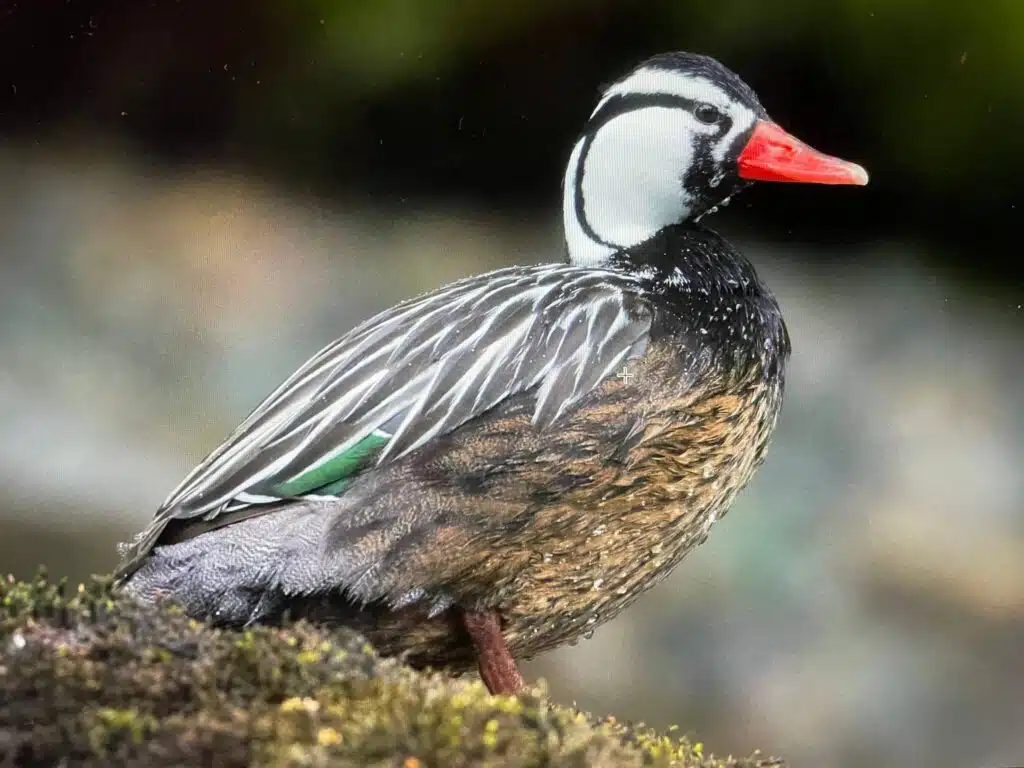
Scientific name: Merganetta armata
Type: shelduck
Torrent Ducks are named after their fast-moving waters habitat. This is a diving species of fast-moving rivers in The Andes.
A narrow-shaped duck, Torrent Ducks are fully adaptable to dealing with rapid waters and may be recognized by their red beaks across their subspecies.
Males and females have different plumage but share the same red beak color. Since the head of males is black and white, their beaks tend to stand out more.
These types of ducks show black and white necks and chests while their wings are gray-brown.
Females are dull-colored with gray-brown nuances.
These types of ducks are rarely seen in groups. They live on their own or in pairs and are often spotted next to rivers, perched on vegetation or rocks where they dive into the water for food.
A distinct ability of the species includes the capacity to swim upstream with apparently little effort.
Distribution: Colombia, Chile
15. Muscovy Duck
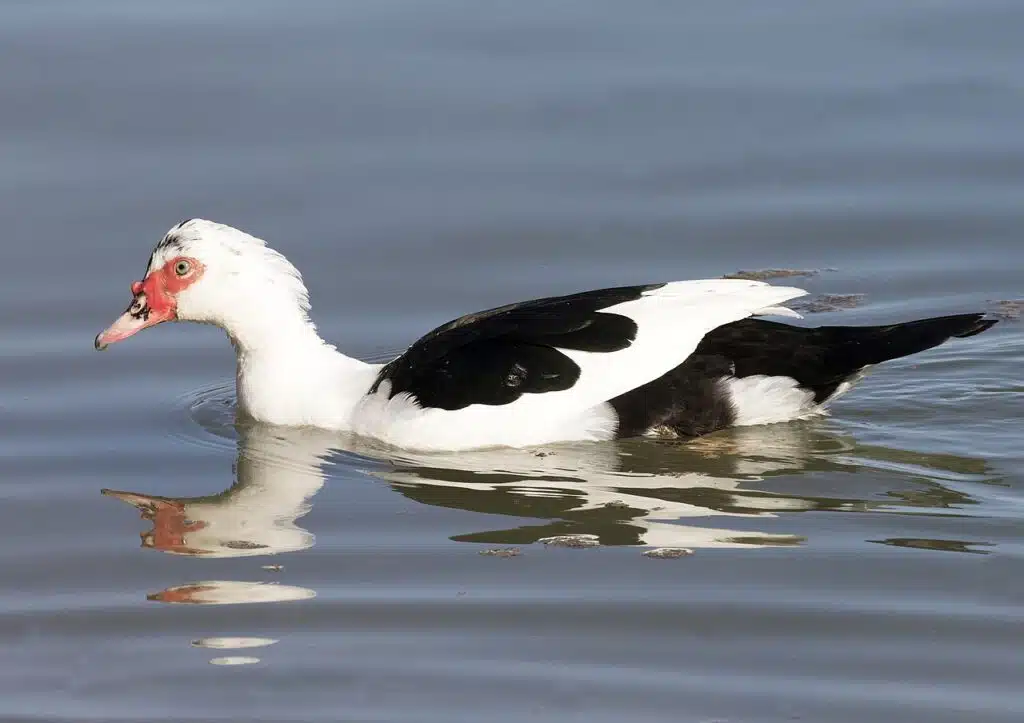
Scientific name: Cairina moschata
Type: feral
Muscovy Ducks have a long history of domesticated ducks. They became feral (a species re-established in the wilderness from domesticated flocks) around the world, including in The United States.
For hundreds of years, these ducks have been bred in large numbers. Today, they can even be pests of crops across various US states.
Males of the species are known for their red beaks and red knobs. They show black-and-white plumage and are also associated with black-and-white variants.
Females may also show a red beak and a red knob. But they tend to have brighter white and gray plumage.
Unlike in other species which only develop their final beak color in adulthood, Muscovy Duck chicks come with a slightly red beak with large gray sections.
The history of these ducks in The US is tied to colonization. They have been introduced on ships as they were known as domesticated ducks in Europe.
Distribution: Central America, South America, Southeastern United States
16. Brazilian Teal
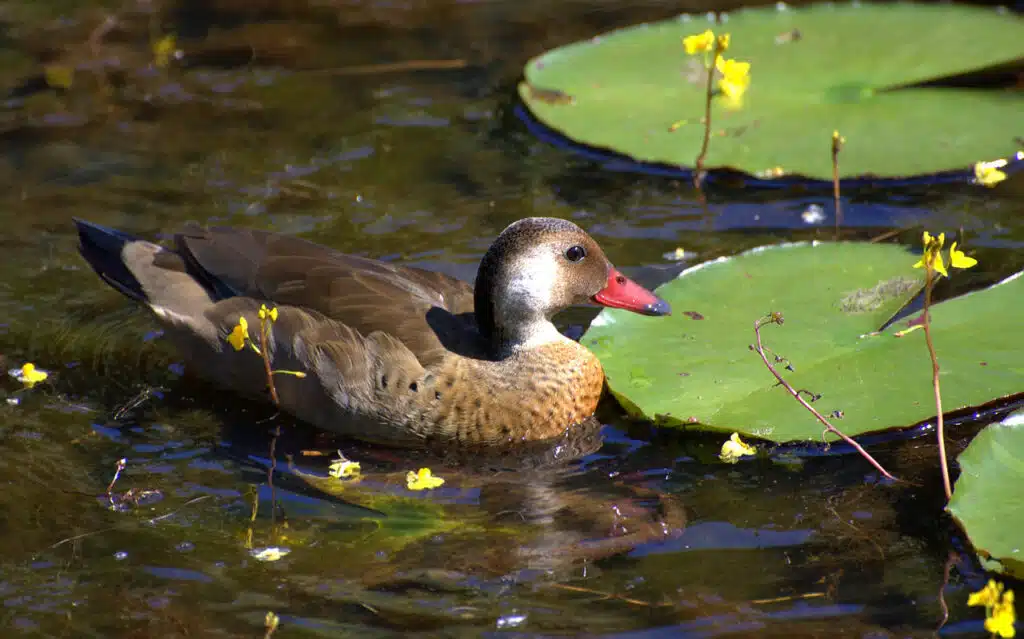
Scientific name: Amazonetta brasiliensis
Type: dabbling duck
A South American native, Brazilian Teals are known for their red beaks.
It’s the males of the species that show red beaks while females have black beaks. A gray-brown color is specific to their heads, bodies, and wings.
The dorsal wings of the species also come with blue-green areas, visible only when its wings are spread out.
Freshwater duck, these ducks are known to take care of their young with both parents.
Even more, Brazilian Teals rarely live in large groups as adults. Pairs and groups of up to several ducks are more specific to the species.
Some of the best areas to spot these ducks include ponds, lakes, and small rivers.
Distribution: Eastern Brazil to Argentina